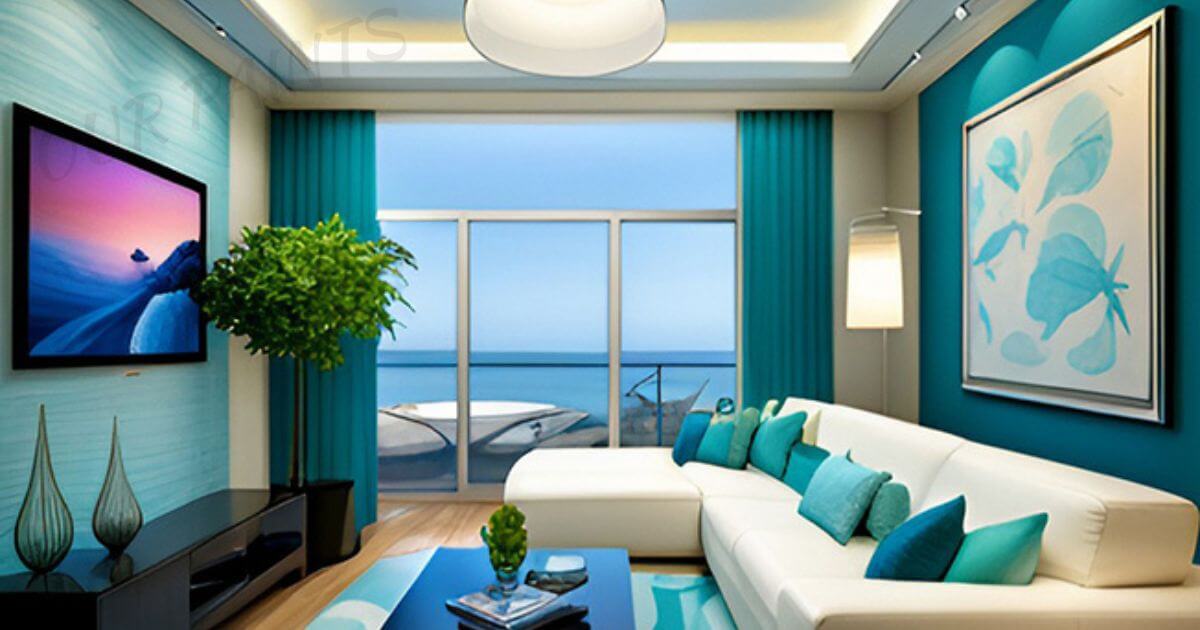Certainly! Designing interior painting ideas for living rooms involves an intricate blend of color psychology, aesthetic coherence, and spatial dynamics. Each brushstroke can transform the ambiance dramatically.
The choice of hues isn’t merely about aesthetics; it’s an expression of emotions and an architect of moods. From the warmth of earthy terracottas to the serene blues and greens, colors wield the power to elevate the room’s energy or instill calmness.
Accompanied by strategic lighting, these colors can accentuate the room’s size, creating an illusion of space or fostering an intimate, snug atmosphere. The interplay between colors, furniture, and textures is a symphony of design elements, shaping the room’s character.
Color Psychology And Mood Elevation:
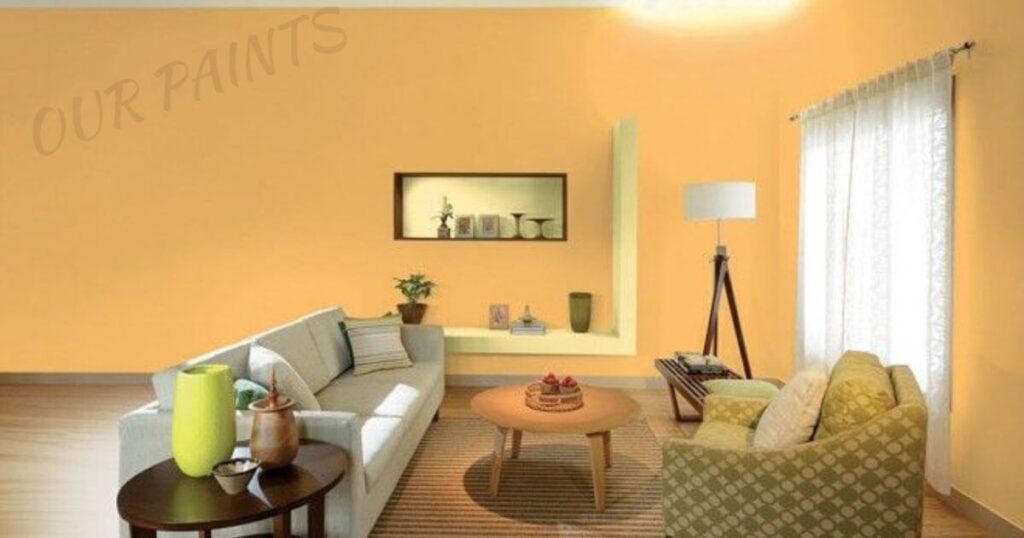
Color psychology within interior design, particularly for the living room, is a fascinating exploration of the emotional impact of hues. It delves into the transformative power of colors, shaping the ambiance, mood, and perception within a space.
Warm tones, such as gentle yellows or earthy terracottas, radiate a sense of intimacy and comfort. These shades induce a welcoming atmosphere, ideal for fostering closeness during family gatherings or intimate conversations.
Emotional Dynamics of Color
Warm hues stimulate feelings of coziness and joy, making them excellent choices for social spaces. Cool tones like serene blues or refreshing greens evoke tranquillity and peace.
Lighter shades impart a sense of expansiveness, making them perfect for smaller living rooms, while deeper tones add depth and sophistication to larger spaces.
Color selection goes beyond aesthetics; it’s an expression of emotions. Red hues spark energy and passion, ideal for lively entertainment areas, while muted pastels or neutrals promote relaxation.
Understanding color psychology allows for intentional mood creation, ensuring the living room aligns with the desired emotional resonance. To further deepen the impact, consider color harmonies. Complementary schemes, such as pairing red with green or blue with orange, create striking contrasts.
Analogous combinations, like blending shades of blue and purple, offer a harmonious and calming effect. Monochromatic palettes, focusing on variations of a single color, imbue elegance and sophistication, creating a cohesive visual narrative.
Choosing the right color palette involves assessing the room’s purpose. For a multi-functional space, a blend of warm and cool tones may strike a balance between vibrancy and serenity.
The room’s natural light plays a pivotal role. South-facing rooms benefit from cooler tones to balance the warmth, while north-facing spaces might require warmer hues to create a cozy atmosphere.
Color psychology is an intricate tool in interior design, influencing not just aesthetics but emotions and interactions. A well-chosen color palette can transform a living room into a sanctuary, aligning with the occupants’ desires for comfort, stimulation, or tranquillity.
It’s the artful orchestration of colors that amplifies the room’s personality, fostering an environment that speaks to the soul and captivates the senses.
Accent Walls And Focal Points:
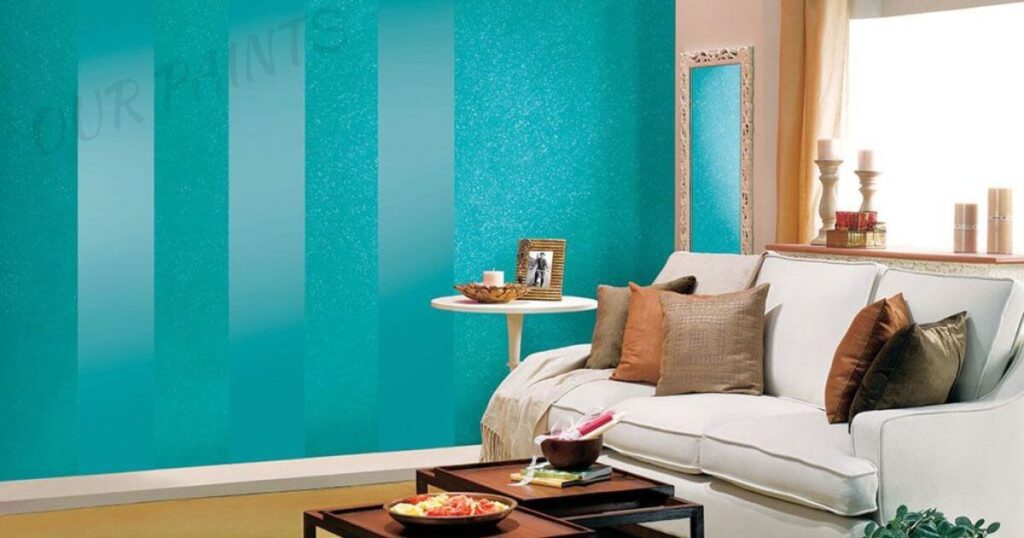
Crafting an accent wall within a living room design adds a charming focal point and sparks visual interest. This design method highlights a specific area, injecting character and depth into the room’s overall look.
It’s a canvas for artistic expression, allowing homeowners to explore vibrant colors, textures, or patterns that complement their decor style.
Striking Colour Contrasts
Accent walls thrive on bold color choices that contrast with the surrounding walls. Vibrant shades against softer tones, like pairing deep blues with gentle greys or rich reds with muted creams, draw attention and elevate the room’s ambiance. This contrast creates an immediate focal point, grounding the space and guiding focus.
Texture and Finishing Touches
Beyond color, textured finishes amplify the impact of an accent wall. Textured paints, wallpapers with intricate designs, or tactile materials such as reclaimed wood or stone veneers add depth and character. Metallic finishes or reflective paints introduce a touch of luxury, catching light to enhance visual drama.
Thoughtful Placement and Harmony
Choosing the right wall for accenting is pivotal. Consider walls that naturally catch the eye or serve as a backdrop for essential furniture pieces. Walls behind the television or framing the fireplace often work well.
Achieving visual harmony between the accent wall and the room’s design elements is essential. Ensuring alignment with furniture, artwork, or rugs maintains coherence while allowing the accent wall to shine.
Moreover, accent walls aren’t limited to solid colors. Experimenting with patterns, murals, or geometric designs transforms a wall into an art piece. Stripes, chevrons, or intricate motifs inject dynamism, adding personality and visual allure.
Accent walls serve various purposes. They delineate spaces within open floor plans, such as separating the living area from the dining space. They serve as splendid backdrops for showcasing art, and shelves, or highlighting architectural features like alcoves or niches.
Achieving a balance between boldness and cohesion is key. While an accent wall should make a statement, it should seamlessly blend into the room’s overall design narrative.
Thoughtfully executed accent walls serve as impactful design elements, enhancing the living room’s aesthetic and inviting appreciation while maintaining a harmonious visual flow.
Play of Light And Space Enhancement:
Manipulating light within a living room through paint choices and strategic design approaches is a transformative tool for optimizing space perception and ambiance. Light profoundly influences how colors are perceived, impacting the room’s atmosphere and spatial feel.
Maximising Natural Light
Utilizing lighter paint shades amplifies the impact of natural light. Soft, neutral tones like creamy whites or pale pastels reflect light, creating an illusion of expansiveness. This technique is particularly effective in smaller living rooms, making them feel brighter and more open.
Artificial Lighting Strategies
Strategic use of artificial lighting complements paint choices. Layering lighting sources—ambient, task, and accent lighting—add depth and warmth to the room. Dimmable fixtures allow control over the room’s ambiance, providing versatility for different activities and times of day.
Visual Illusions and Depth
Painting techniques, such as gradient or ombre effects, create visual illusions of depth and dimension. Vertical stripes elongate walls, making the room appear taller, while horizontal stripes widen spaces.
Glossy finishes reflect light, making walls appear farther away, effectively enhancing the room’s perceived size. Moreover, understanding the room’s orientation and the direction of natural light is pivotal.
North-facing rooms benefit from warm tones to counterbalance the lack of direct sunlight, while south-facing rooms might require cooler tones to prevent overwhelming brightness.
Manipulating light and space through paint choices extends beyond walls. Ceilings painted in lighter hues contribute to an airy feel, while darker ceilings create a cozy atmosphere. Similarly, using the same color on walls and trim provides continuity, visually expanding the space.
Consideration for furniture placement is crucial. Avoiding blocking natural light sources maintains brightness. Strategically placing mirrors amplifies the effect of both natural and artificial light, bouncing it across the room.
The interplay between light and paint transforms a living room. It’s an intricate dance of colors and illumination that affects not just visual aesthetics but also emotional resonance.
By harnessing the power of light manipulation through paint, a living space can be tailored to evoke desired moods, maximize spatial perception, and create an inviting, harmonious environment.
Harmonizing With Furniture And Decor:
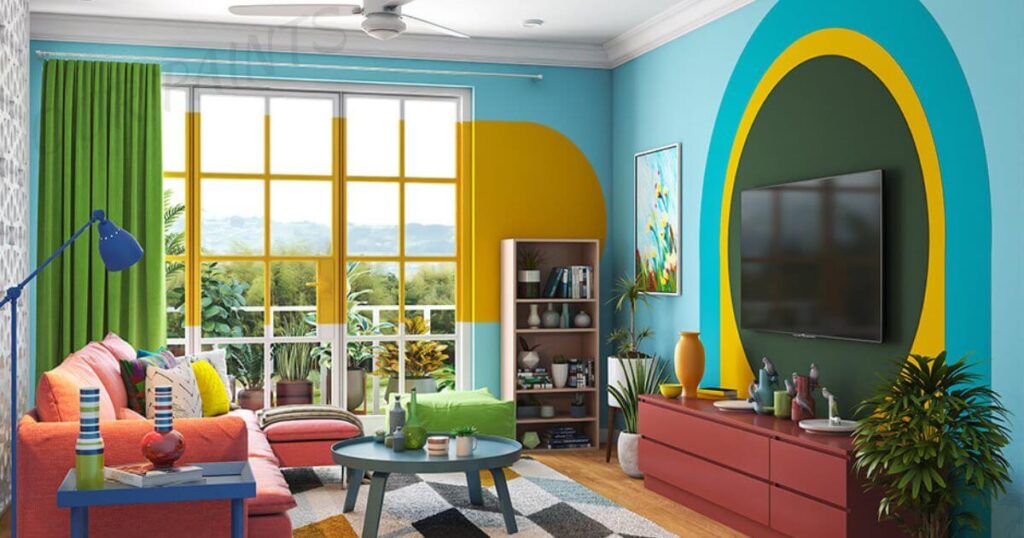
Creating harmony between paint choices and furniture/decor elements in a living room is essential for a cohesive and visually appealing space. It involves thoughtful consideration of how colors interact and complement each other, ensuring a seamless blend of hues and styles.
Coordinating Colour Palettes
Aligning the color palette of the walls with the furniture and decor sets the tone for the room’s ambiance. Consider complementary or analogous color schemes—pairing colors adjacent or opposite on the color wheel—to create a unified look.
For instance, if the furniture features warm tones, like browns or oranges, consider walls in complementary cooler shades like blues or greens for balance.
Balancing Contrast and Complement
The key is finding the right balance between elements that contrast and those that complement. Bold, contrasting colors can add excitement, but they should harmonize with the room’s overall theme.
Neutral walls can serve as a versatile backdrop for vibrant furniture pieces or artwork, allowing them to stand out without overwhelming the space.
Texture and Material Cohesion
Consider the textures and materials present in both furniture and decor when choosing paint colors. Wooden furniture may complement warm tones, while metallic accents or glass elements might align better with cooler hues.
Harmonizing textures—soft fabrics against smoother finishes—create a tactile and visually pleasing environment. Moreover, it’s crucial to take into account the room’s natural light and how it interacts with different colors and materials.
Natural light can enhance certain colors while muting others, impacting how they interact with the room’s elements. Creating a mood board or visual plan can help in envisioning how various colors and textures work together.
Experimenting with swatches and samples before committing to color can provide a clearer understanding of how they’ll interact within the space. Ultimately, harmonizing paint choices with furniture and decor elements is about achieving a cohesive visual narrative.
When done thoughtfully, it creates a harmonious and inviting living room that reflects personal style and aesthetics while ensuring a comfortable and visually pleasing environment for inhabitants and guests alike.
Texture And Finish Variations:
Introducing texture and varied finishes into a living room’s paint choices transcends mere color, elevating walls into multi-dimensional canvases that engage the senses and enrich the space’s visual appeal.
Diverse Finish Options
Exploring diverse finish options, from matte to glossy, satin to textured, empowers homeowners with an array of possibilities. Matte finishes exude sophistication, offering a subtle, velvety appearance that minimizes light reflection, ideal for concealing imperfections on walls.
In contrast, gloss finishes, with their reflective quality, bring vibrancy and light, creating a more luminous atmosphere and making spaces appear larger.
Textural Elegance and Depth
Textured paints, a captivating choice, infuse walls with depth and character. These specialty paints, applied with unique techniques or tools, impart tactile richness—ranging from brushed finishes to more elaborate techniques like stippling or sponging.
These textures create visual interest and play with light and shadow, transforming walls into dynamic elements within the room.
Reflective Surfaces and Light Manipulation
Opting for reflective surfaces, such as metallic or pearlescent finishes, introduces a touch of opulence. These finishes catch and reflect light, lending walls an iridescent quality that adds drama and sophistication to the space.
They’re particularly striking when strategically used on accent walls or focal points, amplifying the room’s allure. Combining different finishes within the same color palette or on adjacent walls creates a harmonious yet visually stimulating contrast.
This technique adds depth and complexity to the room, inviting exploration of its textured surfaces. Understanding the impact of texture and finishes on a room’s ambiance is crucial.
Matte finishes, for instance, absorb light, imparting a cozy and intimate feel, suitable for bedrooms or areas meant for relaxation. Meanwhile, glossier finishes bounce light around, making them perfect for well-lit spaces or rooms with minimal natural light.
Experimenting with textures and finishes extends beyond paint application. Consider wallcoverings, like wallpapers or wall panels, which offer an array of textures—from embossed patterns to intricate designs.
These options provide flexibility, allowing for the creation of personalized spaces tailored to individual preferences. Texture and finish variations in paint choices are a gateway to transforming walls from static backdrops to dynamic design elements.
When applied thoughtfully, they imbue spaces with depth, personality, and an inviting tactile quality, elevating the living room into a visually captivating and sensorially engaging haven.
Incorporating Nature And Artistic Inspirations:
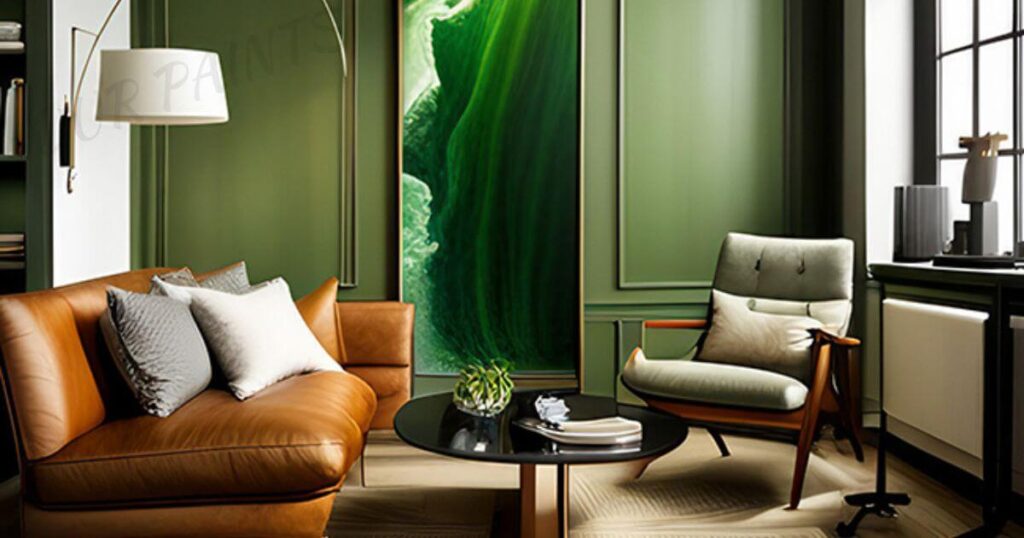
Infusing a living room with elements inspired by nature and art sparks creativity and adds a distinctive charm, turning the space into a canvas that reflects the beauty of the outdoors and artistic expressions.
Natural Colour Palettes
Drawing from nature’s palette, earthy tones like sage greens, sandy beiges, or serene blues bring a sense of tranquillity indoors. These hues emulate the calming presence of landscapes, fostering a serene and peaceful atmosphere within the living room.
Botanical motifs in wallpapers or artwork can bring a touch of the outdoors inside, creating a harmonious connection with nature.
Artistic Flourishes
Art-inspired color palettes introduce an element of artistic flair. Bold and unexpected color combinations derived from artworks or artistic movements, like impressionism or abstract expressionism, infuse the room with personality.
These palettes often incorporate unconventional hues, allowing for creative exploration and adding a unique vibrancy to the space.
Natural Elements and Artistry
Incorporating natural elements such as reclaimed wood accents, stone textures, or indoor plants reinforces the connection to nature. Wooden furniture or decor elements offer warmth and texture, while stone-inspired finishes evoke a sense of groundedness.
Indoor plants not only add a refreshing aesthetic but also contribute to a healthier indoor environment, promoting tranquillity and well-being. Moreover, art-inspired wall murals or hand-painted designs can become captivating focal points.
These bespoke artistic touches inject personality and narrative into the room, telling a unique story and sparking conversations. Considering the room’s layout and natural light is pivotal. Natural colors and materials can complement or contrast existing architectural features, creating a harmonious balance.
North-facing rooms may benefit from warmer, earthy tones to counterbalance limited sunlight, while south-facing rooms might embrace cooler shades to maintain a refreshing ambiance.
Blending nature and artistry isn’t confined to color schemes; it extends to patterns, shapes, and textures. Experimenting with organic patterns, floral motifs, or geometric designs reminiscent of natural formations adds depth and visual interest, amplifying the room’s character.
Incorporating nature-inspired and artistic elements into the living room design transcends mere aesthetics. It fosters a sense of connection with the environment, stimulates creativity, and infuses the space with an inviting, personalized touch.
It’s a delightful fusion of the serene allure of nature and the expressive beauty of art, creating a living room that resonates with tranquillity and individuality.
Customized Patterns And Murals:
Infusing a living room with customized patterns and murals is an artistic endeavor that elevates the space, transforming walls into captivating visual narratives that reflect personality and creativity.
Dynamic Patterns and Designs
Experimenting with dynamic patterns, whether through wallpapers or hand-painted designs, adds depth and character to the walls. Geometric patterns, intricate motifs, or abstract designs create visual intrigue and a sense of movement, making the walls more than mere backgrounds but focal points of artistic expression.
Bespoke Wall Murals
Commissioning or creating bespoke wall murals is a unique way to infuse personality into the living room. These murals can range from nature-inspired scenes to abstract compositions or even personalized artistic expressions. They become stunning centerpieces, adding a touch of exclusivity and storytelling to the room.
Accentuating Architectural Features
Utilizing customized patterns to accentuate architectural features like alcoves, arches, or niches amplifies their visual impact. These patterns can highlight these elements, making them stand out as artistic elements within the room’s design.
Patterns and murals can also cleverly conceal structural flaws or enhance the perceived dimensions of the space. Moreover, these customizations allow for the integration of personal narratives or cultural influences into the living room design.
They serve as conversation starters, invoking emotions or sparking curiosity about the stories behind the artwork. Consideration of the room’s layout and functionality is crucial. Patterns and murals should complement the room’s overall aesthetic without overwhelming the space.
Strategic placement, such as using murals on a single wall or specific sections, prevents visual clutter while ensuring a cohesive design. Technological advancements allow for digital prints or custom designs that cater to individual preferences.
Digital murals offer versatility in scale and detail, enabling intricate designs or expansive scenes that bring a sense of drama and uniqueness to the room. Incorporating customized patterns and murals isn’t just about adding visual appeal; it’s about infusing the living room with personality and storytelling.
It’s a canvas for self-expression, allowing homeowners to imprint their tastes, passions, or memories onto the walls, ultimately creating a space that feels deeply personal and visually captivating.
Seasonal Adaptability And Longevity:
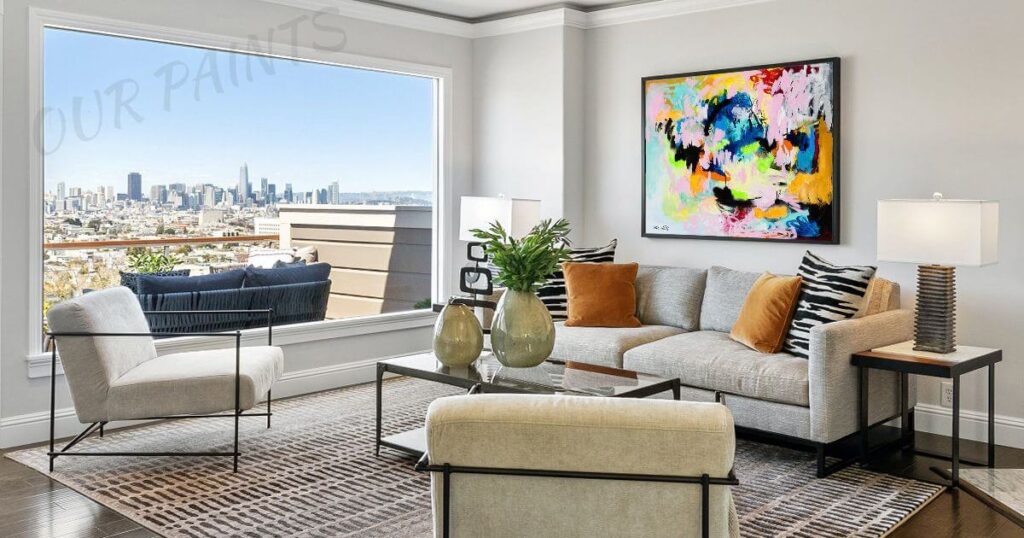
Considering a living room’s seasonal adaptability and longevity in paint choices involves strategic planning to ensure a versatile and enduring aesthetic that transitions seamlessly through the seasons while maintaining timeless appeal.
Versatile Colour Palettes
Opting for versatile color palettes allows for seasonal adaptability. Neutral tones like soft greys, creamy whites, or muted pastels serve as versatile backdrops that easily accommodate seasonal decor changes.
These hues provide a canvas for introducing seasonal accents without clashing with existing color schemes.
Seasonal Accents and Accessories
Embracing seasonal accents through accessories such as throw pillows, rugs, or curtains allows for easy seasonal transformations.
Vibrant hues during spring and summer or warmer, cozier tones in fall and winter can be effortlessly incorporated and swapped to reflect the changing seasons without the need for a complete redesign.
Timeless Elegance in Design
Selecting classic and timeless design elements ensures longevity. Neutral and earthy tones, classic patterns, and durable materials for furniture and decor pieces withstand changing trends.
Incorporating these elements creates a foundation that remains stylish and relevant, transcending seasonal fluctuations. Moreover, considering the room’s natural lighting and its impact on colors throughout the year is vital.
Rooms with ample natural light may accommodate a broader range of colors, while those with limited light might benefit from lighter, more reflective hues. Investing in high-quality paint with durable finishes enhances longevity.
Washable and scrubbable paints maintain their freshness, resisting stains and wear over time, contributing to the room’s longevity. An adaptable living room design doesn’t sacrifice style for practicality.
It’s about striking a balance between timeless elegance and the flexibility to evolve with the seasons. By incorporating adaptable color palettes and timeless design elements, homeowners can create a space that feels fresh and inviting year-round, ensuring enduring charm and versatility.
Conclusion:
In designing a living room’s interior with paint, an array of captivating ideas awaits. From warm, inviting hues like earthy terracottas to serene blues or vibrant jewel tones, the palette is vast.
Accent walls, textured finishes, or bespoke murals elevate the ambiance, adding depth and character to the space. Balancing colors with furniture and decor, playing with light and space, and considering seasonal adaptability ensure a harmonious, personalized, and enduringly stylish living room.
Whether it’s about creating a cozy haven or an eclectic statement, the world of interior painting offers limitless possibilities to infuse personality and charm into your living space.
Faqs About Interior Painting Ideas For Living Room:
What are trending color schemes for a modern living room?
Modern living rooms often embrace neutral palettes with a pop of bold color. A trending combination is soft grey or beige walls complemented by vibrant accent furniture or decor in jewel tones like emerald green or deep sapphire blue.
How can I create a cozy living room with paint?
Opt for warm and inviting colors such as rich browns, warm terracottas, or deep burgundy. Accentuate the coziness with textured finishes like matte paint or wallpapers with soft patterns. This creates a snug atmosphere ideal for relaxation.
What’s the best way to choose a color that enhances natural light?
For rooms with ample natural light, consider light and airy colors like soft blues, pale yellows, or creamy whites. These hues maximize the brightness and contribute to an open, airy feel.
How can I incorporate nature into my living room through paint?
Infuse natural elements by choosing earthy tones such as forest greens, sandy beiges, or ocean blues. Consider nature-inspired patterns or botanical wallpapers to bring a touch of the outdoors inside.
Are accent walls still in style, and how can I make them stand out?
Yes, accent walls remain in vogue. To make them stand out, opt for bold colors that contrast with the surrounding walls. Experiment with textured finishes, geometric patterns, or even a striking mural for added visual appeal.
Can I experiment with multiple colors in a small living room?
Yes, you can! In smaller spaces, consider a cohesive color palette with variations in tone. Use lighter shades for the walls to create an illusion of space, and introduce bolder colors through accent furniture or decor.
How can I ensure my living room paint remains stylish over time?
Choose timeless colors like muted greys, soft blues, or classic whites. Combine these with durable finishes and versatile design elements to ensure your living room stays stylish and adaptable to changing trends.

